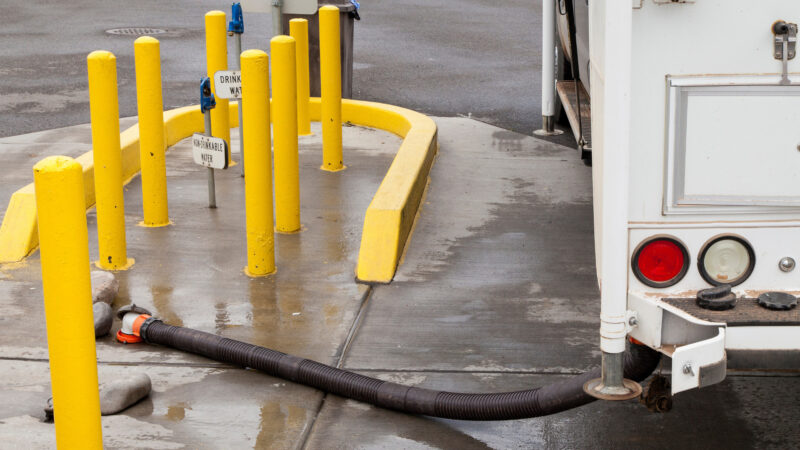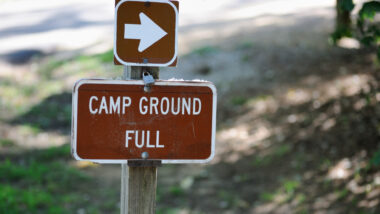Table of Contents Show
One of the most critical RV maintenance tasks is cleaning your camper’s black water tank. Using a black water flush system is an effective and efficient way to eliminate waste and debris that has accumulated inside the tank.
The hose to fill your fresh water tank can easily connect to your black water flush. But should it? Should you use a separate hose for your black water flush?
Today, we’re answering this important question and sharing some tips for flushing your black water tank. We’ll even share a couple of hose options worth considering.
Let’s get started!
What Is a Black Water Flush?
A black water flush is part of some RV plumbing systems. It allows the owner to clean the waste and debris inside the black water tank. This system typically involves a separate inlet valve, allowing a high-pressure stream of water into the tank.
The water can dislodge and flush out waste and debris remaining inside the tank. This improves the overall cleanliness and functionality of the system.
Using a black water flush system can help to prevent clogs, reduce odors, and improve the lifespan of your RV’s plumbing system. Unfortunately, not every RV comes with a black water flush connection. If your rig does, you better make sure to use it.
Read More: Your black water tank is one of the most important parts of your RV. Learn more about how your RV black water tank works!
How Often Should You Flush Your Black Tank?
How often you should flush your black tank will depend on how you use your RV.
For those using their rig on weekends or recreational adventures, flush black tanks after every trip. This is especially true if you’ll have more than a week or two between trips. If not, you could return to an unpleasant odor the next time you enter your camper.
On the other hand, some RVers use their trailers to travel full-time. They may not need to flush the system every time they empty their tanks. This is because you’re likely dumping your tanks regularly. You can typically get by with cleaning your tanks after every few dumps.
Should You Use a Separate Hose for Your Black Water Flush?
You should always use separate hoses for your black water flush and freshwater. While most black water flush systems typically use backflow prevention mechanisms, they’re not always 100% effective.
Some owners have experienced these valves getting stuck, which can allow liquids in the black tank to flow out and into the connected hose.
If this were to occur, you’d end up with contaminated liquids getting into your drinking water hose. It’s better to be safe than sorry. We suggest you use a designated hose for drinking water and your black water flush, and never mix the two.
How to Flush Your Black Water Tank
If you want the best shot of avoiding issues with your black tank, you must flush it regularly.
Let’s walk through the steps you should take each time you use your black tank flush connection. It’s not hard or too time-consuming, but consistency can help avoid odors and issues.
Wear Protection
Before getting started, grab some protection to avoid coming in contact with contaminated liquids and equipment. Many RVers wear rubber gloves, safety glasses, and a mask.
Even if you’re as safe as possible, there’s still a chance for spillage or drippage. In addition, sewer hoses and attachments will likely have bacteria living in them.
Connect RV to Sewer Connection
Next, you need to connect your RV to a sewer connection. The best place to do this is at a campsite. These sites provide everything you need to flush your black water tank. Take your time to ensure you get the best results.
If your campsite doesn’t have a sewer connection, you can use a nearby dump station. Many campgrounds have these available. Unfortunately, lines can get pretty long, especially if you’re leaving on a Sunday.
If you know you’ll need to flush your tank, consider leaving during a less busy time. You don’t want to hold up the line and force others to wait longer than necessary.

Dump Tanks and Close Valves
After ensuring your hose and attachment connections are secure, it’s time to start dumping your tanks.
You should empty your black tanks first and finish with gray water. This helps flush out any remnants of toilet paper or other solids that stick to the inside of your sewer hoses and attachments.
With your tanks completely emptied, it’s time to close your valves. This is an important step that will be essential to help make flushing your tanks as quick and easy as possible. Leaving them open will make it nearly impossible to do a thorough job.
Pro Tip: Do you know how to use an RV dump station? Take a look at our step-by-step guide to learn how to use an RV dump station!
Connect Black Water Flush Hose and Fill Tank
The next step is to connect the designated black water flush hose. Connect this hose while dumping your tanks to be as efficient as possible.
This can help you save a minute or two in the process. This may not seem like much time savings, but the people behind you at the dump station will appreciate it.
With your black water flush hose connected, turn on the water connection and start filling your tank. You can’t walk away or get distracted from this task. If you do, you could overfill the tank and cause serious damage.
If you know the size of your black tank, you can use a water flow meter to monitor how much you’ve put into it easily.
- KNOW WHERE THE WATER GOES---Do you know how much water you've watered your garden or prepare how much water for a RV...
- HIGH-PRECISION WATER FLOW METER---Built-in with hall sensor and sensitive IC chip, processing water flow via impeller...
Rinse and Repeat as Necessary
Once you’ve filled it three-quarters full, you’ll want to open your black tank valve.
The first time you do this, you’ll likely notice a considerable amount of gunk flushing from the system. This is normal and nothing to worry about. Repeat this process until you only see clear water when dumping your tanks.
Filling your black tank with clean water can be the most time-consuming part of the process. Depending on how much water pressure is at the connection, it could take 10 minutes or more each time you need to fill your tanks.
This is why we encourage you to be considerate of others, especially if it will require you to fill and dump your black tank multiple times.
Best Black Water Flush Hoses
Having a designated black water flush hose is important. While safety measures are in place to prevent contamination, it’s better to be safe than sorry.
If you’re looking for a designated black water hose, we’ve found some options to get the job done. Let’s take a look!
Camco Rhino 25-Foot RV Clean-Out
If you want to easily tell the difference between your drinking water hose and your black water flush hose, the Camco Rhino hose makes it easy. That’s because it’s bright orange, which will make it nearly impossible to mistake for a potable water hose.
It comes in 25-foot sections and is made from a thick PVC material, meaning it’ll last for years.
The Camco Rhino clean-out hose uses standard thread connections. This means it’ll easily connect to any water or black water flush connection. Since it comes from a trusted brand like Camco, you can have peace of mind when buying this hose.
- Clean-Out RV Sanitation Hose: Camco’s Rhino 25' Clean-Out Hose efficiently cleans out black and RV grey water tanks,...
- 25' Extended Length: With a generous 25' length and 5/8″ internal diameter, accessing your RV's sewer tanks is...
rVandtt 35ft RV Grey/Black Tank Cleanout Water Hose
If you want to ensure no confusion about which hose you should use to flush your black tank, the rVandtt cleanout hose takes things further.
The hose has a convenient storage bag that reads “black tank flush.” If that’s not enough, rVandtt prints “black tank flush only” several times on the outside of the hose. There should be no confusion as to the purpose of this hose.
Another benefit of the rVandtt cleanout hose is that it measures 35 feet long. While most campsites and situations only require 30 feet, it’s nice to know you’ll have a few extra feet to work with when needed. You never know when those additional few feet will make a difference.
- RELIABLE RV SANITATION HOSE: Upgrade to the rVandtt Hose for lasting durability. This 35ft, 5/8" diameter hose is ideal...
- VERSATILE DESIGN: Our RV water hose features no memory and an anti-kink design for effortless positioning and storage....
Use the Right Hose to Flush Your Black Water Tanks
Using the right hose to flush your black water tanks is essential to maintain the proper functioning of your RV’s sanitation system.
A high-quality, dedicated black tank flush hose designed for this purpose ensures that your tanks get cleaned thoroughly and efficiently. In addition, you’ll minimize the risk of damage or contamination.
Take the time to select the right hose and follow proper flushing procedures. Doing so can help ensure your RV’s black water tanks remain clean, odor-free, and functioning properly. This can allow you to enjoy a hassle-free and comfortable camping experience.
Last update on 2024-10-23 / Affiliate links / Images from Amazon Product Advertising API









